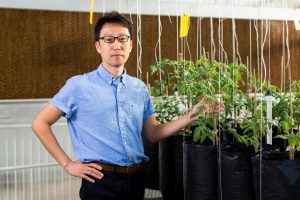Florida growers produced 606 million pounds of fresh-market tomatoes last year, which brought in $463 million in revenue. But with competition from places like Mexico, farmers are always looking for an edge – to grow more and bigger fruit.
That’s why University of Florida scientist Tong Geon Lee spends countless hours in his lab and fields looking for the right combination of genes to expand the size of individual tomatoes and to help growers increase their yields.
“Fruit size, especially large fruit, is a particularly important trait for fresh-market tomato production, especially in the United States, because of the market demand,” said Lee, a UF/IFAS assistant professor of horticultural sciences at the Gulf Coast Research and Education Center. “I’m particularly interested in the size and quantity of fruit per plant. Growers could make more money if they have tomato plants that produce more large fruit on each plant. I’m also interested in other yield-related traits such as longer shelf life.”

Many factors go into a larger harvest, including tomatoes that resist pests and diseases. Lee also looks for genes that can help offset those stressors.
Lee presented his latest research to growers this week at the Florida Tomato Conference in Labelle. In his most recent research, Lee is using a combination of genome-sequencing, statistics and advanced math to find a consistent pattern of DNA associated with increased tomato production and size.
Finding that genetic combination can prove painstaking. Every tomato contains about 35,000 genes. Each gene, a collection of DNA, is responsible for traits such as the red color you associate with most tomatoes. Genes also play a role in the size of tomatoes and how many can grow on one plant.
“With the completion of this project, we should eventually be able to provide the information necessary for the enhancement of tomato yield through breeding,” Lee said. “Especially high yield is important because with it, we can help ensure food security with good-quality tomatoes. Farmers can increase profits as well.”
Any increase in tomato production depends greatly on how well Lee can line up tomato genes with phenotypic traits – flavor, disease- and pest-resistance are among them. Those matchups are known as “DNA association signals.”
He and his research team have identified several association signals of DNA with good traits by focusing on current tomatoes bred by scientists at UF/IFAS and other institutions.
Lee can’t quantify how many more tomatoes his genetic research will yield. He just knows there will be more tomatoes in Florida’s fields. Zhengfei Guan, a UF/IFAS associate professor of food and resource economics, illustrates current tomato production in Florida and across the country, in 2020 figures:
- Florida produced 606 million pounds in fresh-market tomatoes.
- United States growers produced a total of 1.2 billion pounds.
- Florida’s tomato production is valued at $463 million.
- United States tomato production is valued at $721 million.
With results from his ongoing genetic research, Lee said: “More tomatoes will be shipped to markets, restaurants, cruise lines and school cafeterias — if we can find the right genetic combination to grow high-yield tomatoes.”
-30-
The mission of the University of Florida Institute of Food and Agricultural Sciences (UF/IFAS) is to develop knowledge relevant to agricultural, human and natural resources and to make that knowledge available to sustain and enhance the quality of human life. With more than a dozen research facilities, 67 county Extension offices, and award-winning students and faculty in the UF College of Agricultural and Life Sciences, UF/IFAS brings science-based solutions to the state’s agricultural and natural resources industries, and all Florida residents.
 0
0

Comments are closed.